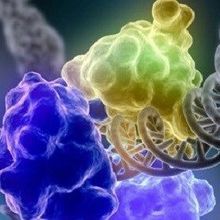Login
Subscribebase editing

Targeting a Genetic Accident to Treat Disease
Deanna MacNeil, PhD | May 9, 2023 | 2 min read
David Liu shares how integrating chemistry and evolution in his research has directed his work on base editing techniques aimed at developing new therapeutics.

On the Hunt for the Next Breakthrough in Motor Neuron Disease
Deanna MacNeil, PhD | May 9, 2023 | 3 min read
Researchers leave no stone unturned in the search for a spinal muscular atrophy treatment strategy that uses base editing.

Molecular Glue ‘Shreds’ Cas9 and Enables a New Form of CRISPR Control
Ida Emilie Steinmark, PhD | Apr 26, 2023 | 3 min read
In a bid to address safety concerns about immune reactions during treatment with CRISPR-based therapeutics, a new technique speeds up how quickly the body destroys the DNA-cutting enzyme Cas9.

Can “Gene Writing” Deliver What Gene Editing Can’t?
Dan Robitzski | Dec 12, 2022 | 10+ min read
A biotech startup called Tessera Therapeutics has made a splash with its claims about the trademarked technology. Is the excitement justified?

A CRISPR Alternative for Correcting Mutations That Sensitize Cells to DNA Damage
Deanna MacNeil, PhD | Oct 10, 2022 | 3 min read
Researchers turned to base editors to correct mutations causing the rare genetic disease Fanconi anemia without inducing double-strand DNA breaks.

First Person Dosed in Novel Gene Editing Clinical Trial
Amanda Heidt | Jul 12, 2022 | 4 min read
The biotech company Verve Therapeutics launched the study with the aim of using base editing to treat a genetic condition that causes high cholesterol and increases a person's risk of developing cardiovascular disease.

Technique Talk: Understanding Cancer One Base Edit at a Time
The Scientist’s Creative Services Team | May 19, 2022 | 1 min read
Francisco J. Sánchez-Rivera will discuss strategies to design CRISPR base editor libraries for in vivo applications.

In Editing RNA, Researchers See Endless Possibilities
Christie Wilcox, PhD | Dec 1, 2021 | 10 min read
RNA editing has been in DNA editing’s shadow for nearly a decade, but recent investments in the technology could bring it into the limelight.

New Gene Editing Tool Corrects Mutations in Mitochondrial DNA
Amanda Heidt | Jul 9, 2020 | 3 min read
An enzyme pulled from toxic bacteria can enter the organelle and perform single-nucleotide DNA swaps.

New “Prime Editing” Method Makes Only Single-Stranded DNA Cuts
Emma Yasinski | Oct 21, 2019 | 4 min read
In demonstrations in cell lines, the technique has a similar efficacy to CRISPR-Cas9, but fewer off-target effects.

Base Editors Cause Off-Target Mutations in RNA
Catherine Offord | Apr 18, 2019 | 2 min read
A new study indicates that the modified CRISPR-Cas9 technology will need to be further refined before it can safely be used for research and therapeutic applications.

Better Base Editing in Plants
Ruth Williams | Feb 1, 2019 | 3 min read
Adenine editing enzymes have been adapted for use in plants.

Infographic: Plant Genome Editors Get A New Tool
Ruth Williams | Feb 1, 2019 | 1 min read
Adenine editing enzymes have been adapted for use in plants.

CRISPR Editing Heads Off Disease in Mouse Livers
Shawna Williams | Oct 9, 2018 | 2 min read
Separate proof-of-concept studies report success against two inherited diseases.

Base Editing Now Able to Convert Adenine-Thymine to Guanine-Cytosine
Catherine Offord | Oct 25, 2017 | 8 min read
With the arrival of a new class of single-nucleotide editors, researchers can target the most common type of pathogenic SNP in humans.

Technique Adapted from CRISPR-Cas9 Corrects Mutation in Human Embryos
Catherine Offord | Sep 28, 2017 | 2 min read
Researchers use base-editing to swap out an erroneous nucleotide responsible for a potentially life-threatening blood disorder.

CRISPR: No Cutting Required
Anna Azvolinsky | Aug 4, 2016 | 3 min read
Combining a modified Cas9 enzyme with an unrelated one derived from the immune system of the sea lamprey, researchers demonstrate yet another way to edit a single DNA nucleotide.

Advances in Genome Editing
Catherine Offord | Apr 20, 2016 | 4 min read
Researchers develop a CRISPR-based technique that efficiently corrects point mutations without cleaving DNA.
